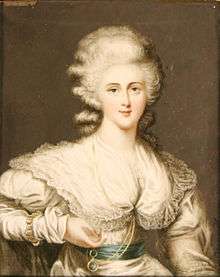Robert Child (Wells MP)

Robert Child (February 1739 – 28 July 1782) was an English banker and politician. He was the Member of Parliament (MP) for Wells from 1765 until his death.[1]
Career
He was the second surviving son of Samuel Child MP, and younger brother of Francis Child. In 1763, he succeeded his brother as nominal head of the family's bank, Child & Co., bringing him an annual income of over £30,000 (£3.33 million in 2016[2]).[1] He also inherited the estate of Osterley Park in Middlesex, where he continued his brother's project of remodelling the house to the designs of Robert Adam.[3]
Child contested Aylesbury at a by-election in 1764, but withdrew due to ill-health.[1] The following year he contested Wells, and after a bitterly fought campaign, two polls were held; one returned Child, the other his rival Peter Taylor, a local grocer's son who grown rich as an army commissary in Germany during the Seven Years' War.[4] In early 1766 Child was awarded the seat on petition.[4] He appears never to have spoken in the House of Commons, and voted largely with the opposition despite his bank's significant business with the government.[1]
Personal life and family

In October 1763, Child married Sarah Jodrell, daughter of Gilbert Jodrell of Ankerwyke, Buckinghamshire.[1] They had only one child, a daughter Sarah Anne (born 1764), who in May 1782 eloped to Gretna Green to marry the 10th Earl of Westmorland. Her father abhorred the Earl, and pursued the couple until one of his horses was shot by Westmorland's men. Her father had approved the marriage before his death in July that year, but disinherited her to prevent his fortune falling into Westmorland's hands.[5]
Instead, his wife Sarah inherited a life interest in the bank, where she remained a senior partner until her death in 1793.[5] She remarried in 1791, to Francis Reynolds-Moreton, 3rd Baron Ducie,[6] but excluded him from the running of the bank.[5] After her death, her husband's will settled his estate on the second surviving son or eldest daughter of Sarah Anne. However, only one of Child's grandsons survived, so the estate — including Osterley Park and the senior partnership in the bank — passed to Sarah Sophia Fane, his eldest granddaughter. She married George Child Villiers, 5th Earl of Jersey, but like her grandmother she ran the bank without admitting her husband to the partnership.[5]
Her wealth was so great that on her marriage in 1805 she gave £20,000 (£1.46 million in 2016[2]) each to her father, her brother and two sisters, but still had an annual income from her inheritance of over £60,000 (£4.39 million in 2016[2]).[7]
References
- 1 2 3 4 5 Christie, I. R. (1964). L. Namier; J. Brooke, eds. "CHILD, Robert (1739-82), of Osterley Park, Mdx". The History of Parliament: the House of Commons 1754-1790. Boydell and Brewer. Retrieved 2 December 2015.
- 1 2 3 UK CPI inflation numbers based on data available from Gregory Clark (2016), "The Annual RPI and Average Earnings for Britain, 1209 to Present (New Series)" MeasuringWorth.
- ↑ Reynolds, Susan, ed. (1962). "Heston and Isleworth: Osterley Park". A History of the County of Middlesex: Volume 3, Shepperton, Staines, Stanwell, Sunbury, Teddington, Heston and Isleworth, Twickenham, Cowley, Cranford, West Drayton, Greenford, Hanwell, Harefield and Harlington. London: Victoria County History. pp. 100–103. Retrieved 2 December 2015 – via British History Online.
- 1 2 Cannon, J. A. (1964). L. Namier; J. Brooke, eds. "Wells 1715–1754". The History of Parliament: the House of Commons 1754-1790. Boydell and Brewer. Retrieved 2 December 2015.
- 1 2 3 4 Dawes, Margaret; Selwyn, Nesta (2010). Women Who Made Money: Women Partners in British Private Banks 1752–1906. Trafford Publishing. pp. 1–2. ISBN 978-1426937255.
- ↑ Burke, John (1832). A General and Heraldic Dictionary of the Peerage and Baronetage of the British Empire. London: H. Colburn and R. Bentley. p. 396.
- ↑ Bittermann, Rusty; McCallum, Margaret (2008). Lady Landlords of Prince Edward Island: Imperial Dreams and the Defence of Property. McGill-Queen's University Press. p. 54. ISBN 9780773533899.
| Parliament of Great Britain | ||
|---|---|---|
| Preceded by Clement Tudway Lord Digby |
Member of Parliament for Wells 1765–1782 With: Clement Tudway |
Succeeded by John Curtis Clement Tudway |